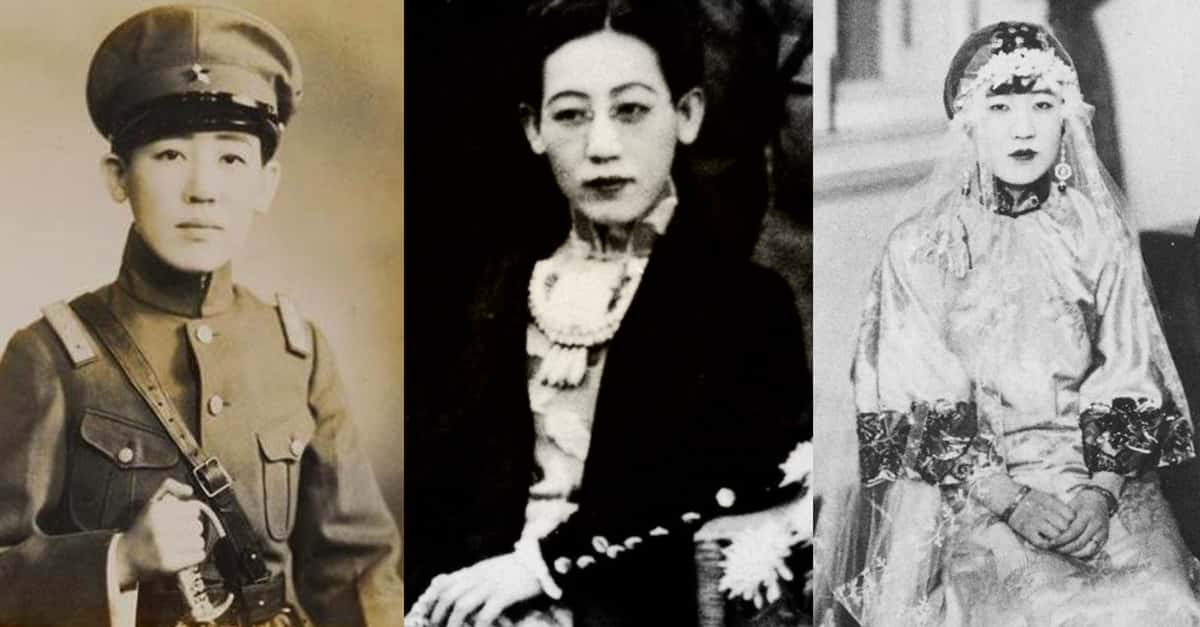
Yoshiko Kawashima lived a life filled with intrigue, deception, and drama. Born as Aisin Gioro Xianyu in 1907, she was a Qing Dynasty princess who transformed into one of Asia's most notorious spies. Her journey took her from the palaces of Beijing to the battlefields of Manchuria, where she served the Japanese Kwantung Army during the Second Sino-Japanese War. Known for her cross-dressing and complex gender identity, Yoshiko's life was a blend of bravery and betrayal. Her relationships with high-ranking military officers and her role in establishing Manchukuo as a puppet state added layers to her enigmatic persona. Despite her controversial actions, her story continues to captivate and perplex historians and the public alike.
Key Takeaways:
- Yoshiko Kawashima, a controversial figure, lived a dramatic life as a spy and puppet state influencer during the Second Sino-Japanese War, leaving a lasting impact on Asian history and popular culture.
- Known for her espionage career, cross-dressing, and romantic relationships, Yoshiko Kawashima's enigmatic life continues to captivate and intrigue people worldwide, inspiring numerous works of fiction and non-fiction.
Early Life and Background
Yoshiko Kawashima's life began in a world of privilege and complexity. Her early years set the stage for her future as a spy and a controversial figure.
-
Birth and Early Life: Born in Beijing in 1907, Yoshiko Kawashima entered the world during the final years of the Qing Dynasty, a time of significant change in China.
-
Family Background: She was one of 38 children of Prince Shanqi, a Manchu prince related to the Qing Dynasty. Her mother, a concubine, meant Yoshiko was not in line for the throne.
-
Name Variations: Throughout her life, she was known by many names, including Aisin Gioro Xianyu, Eastern Jewel, and Jin Bihui. Her most famous moniker was Yoshiko Kawashima.
Personal Life and Relationships
Yoshiko's personal life was as dramatic and complex as her professional one. Her relationships and lifestyle choices often made headlines.
-
Marriage and Divorce: At 20, Yoshiko married Ganjuurjab, the son of an Inner Mongolian Army general. The marriage ended in divorce after three years, leading her to China and later Japan.
-
Bohemian Lifestyle: Post-divorce, she lived a bohemian lifestyle in Tokyo with various rich lovers, both men and women. She later moved to Shanghai and got involved with Japanese military attaché Ryukichi Tanaka.
-
Romantic Relationships: Her personal life was marked by romantic drama. She romanced a Manchurian actress named Yoshiko and had relationships with several high-ranking military officers, including General Kenji Doihara and Colonel Tada Hayao.
Espionage Career
Yoshiko's espionage career is what truly set her apart. Her work as a spy for the Japanese Kwantung Army and Manchukuo during the Second Sino-Japanese War made her infamous.
-
Espionage Career: She began her espionage career in 1927, serving as a spy for the Japanese Kwantung Army and Manchukuo. She undertook undercover missions in Manchuria, often disguising herself as a man.
-
Cross-Dressing: Known for her cross-dressing, she used it both professionally and personally. She dressed as a man to impress men and fit into guerrilla groups without attracting attention.
-
Relationship with Puyi: Yoshiko was well-acquainted with Puyi, the last emperor of the Qing dynasty. She convinced him to become the puppet emperor of Manchukuo, though she privately criticized him for being too weak.
Role in Manchukuo
Yoshiko played a significant role in the establishment and operation of Manchukuo, a puppet state created by the Japanese in Manchuria.
-
Role in Manchukuo: She was crucial in establishing Manchukuo as a puppet state. She managed to persuade Puyi to accept the role, which was vital for Japanese military control over the region.
-
Battle of Rehe: Yoshiko played a significant role in the Battle of Rehe in 1933. She convinced the Japanese Kwantung Army to participate, sparked by the kidnapping and killing of a Japanese soldier by Chinese generals.
-
Title of Commander Jin Binhui: Due to her military prowess and strategic thinking, she was given the title of Commander Jin Binhui. Her bravery and leadership earned her the nickname "Joan of Arc of the Orient".
Later Years and Downfall
Yoshiko's later years were marked by addiction, financial struggles, and eventual arrest and execution.
-
National Celebrity in Japan: After being sent back to Japan, Yoshiko became a national celebrity. She was invited to parties, gave speeches, and appeared on the radio. Her life was the subject of a bestselling novel, Beauty in a Man’s Attire, by Muramatsu Shofu.
-
Retirement from Espionage: In 1942, Yoshiko retired from espionage activities and lived a solitary life. However, the Japanese military remained suspicious of her and even planned to assassinate her.
-
Blackmailing Activities: During her retirement, she engaged in blackmailing activities to extort money from wealthy Chinese citizens. This behavior further damaged her reputation and led to her eventual arrest.
-
Addiction and Health Issues: By the end of World War II, Yoshiko was addicted to morphine and opium. She also suffered from syphilis, which further deteriorated her health and mental state.
-
Return to Beijing: After the Japanese surrender, she returned to Beijing, where she stayed until her arrest. Her life in Beijing was marked by financial struggles and addiction.
-
Arrest and Trial: In October 1945, Chinese troops recaptured Beijing, and Yoshiko was arrested by the Chinese authorities. She was charged with treason and labeled a hanjian, or "race traitor," in a highly publicized trial.
-
Execution: On March 25, 1948, Yoshiko Kawashima was executed by firing squad in a frost-covered prison courtyard. She was 42 years old at the time of her death.
Legacy and Cultural Impact
Yoshiko Kawashima's life continues to captivate and intrigue people worldwide. Her story has been immortalized in various forms of media.
-
Legacy: Despite her controversial life and tragic end, Yoshiko remains a fascinating figure in history. Her exploits captured the imagination of millions in Japan, while to the Chinese, she was a traitor.
-
Popular Culture: Her life has inspired numerous works of fiction and non-fiction. She was portrayed in Bernardo Bertolucci's 1987 film The Last Emperor and has been the subject of several novels and biographies.
-
Historical Impact: Yoshiko's role in establishing Manchukuo as a puppet state and her involvement in various military campaigns during the Second Sino-Japanese War have made her a significant figure in Asian history.
-
Controversy and Perception: Her life was marked by controversy. While seen as a heroic figure in Japan for her espionage activities, she was viewed as a traitor by the Chinese for her role in supporting Japanese occupation.
-
Personal Expression: Yoshiko's love for cross-dressing was not just a tool for espionage but also a means of personal expression. Her flamboyant nature and penchant for dressing in men's clothes made her stand out in an era where gender roles were rigidly defined.
-
Romantic Relationships: Her romantic relationships were often tumultuous and dramatic. She had affairs with several high-ranking military officers and even romanced a Manchurian actress named Yoshiko, adding to her enigmatic persona.
-
Enduring Enigma: Despite the passage of time, Yoshiko Kawashima remains an enduring enigma. Her life, marked by both bravery and betrayal, continues to fascinate historians and the public alike.
-
Cross-Dressing and Gender Identity: Yoshiko's cross-dressing was not just a tool for espionage but also a reflection of her complex gender identity. Many historians believe she was bisexual, and her love for dressing in men's clothes was a part of her personal expression.
-
Undercover Missions: She undertook several undercover missions in Manchuria, often dressing as a man to blend in with guerrilla groups. She was known for her striking appearance and dominating personality, which made her a formidable spy.
-
Relationship with Colonel Tada: In 1933, Yoshiko became friends with Colonel Tada Hayao, the Commander of the Japanese Army in Northern China. She convinced him that it would be better for the Japanese to control Manchuria through the Manchus rather than directly.
-
House Arrest: In 1941, Yoshiko was placed under house arrest in Japan. General Hayao Tada, one of her rumored lovers, attempted to have her killed but ultimately transferred her to house arrest instead.
-
Return to Beijing: After the Japanese surrender in World War II, Yoshiko returned to Japanese-occupied Beijing. She spent her remaining years there, struggling with addiction and financial issues.
-
Trial and Execution: In October 1947, Yoshiko was put on trial for treason. Despite her claims that she did not betray her country, she was given the death penalty. Her execution took place on March 25, 1948, in a frost-covered prison courtyard.
-
Final Words: Before her execution, Yoshiko wrote a letter to Naniwa Kawashima, her foster father. She then knelt down and was shot once in the back of the head, dying instantly at the age of 42.
-
National Celebrity in Japan: After being sent back to Japan, Yoshiko became a national celebrity. She was invited to parties, gave speeches, and appeared on the radio. Her life was the subject of a bestselling novel, Beauty in a Man’s Attire, by Muramatsu Shofu.
-
Legacy in Popular Culture: Despite her tragic end, Yoshiko's legacy continues to captivate audiences. Her life has been immortalized in films, novels, and biographies, ensuring that her story remains a part of historical and cultural discourse.
The Enigmatic Legacy of Yoshiko Kawashima
Yoshiko Kawashima's life was a whirlwind of intrigue, deception, and drama. Born a Qing Dynasty princess, she transformed into one of Asia's most infamous spies. Her cross-dressing, espionage missions, and complex relationships made her a figure of both admiration and scorn. While celebrated in Japan, she was vilified in China as a traitor. Her involvement in establishing Manchukuo and her daring missions during the Second Sino-Japanese War left a lasting impact on history. Despite her tragic end, executed for treason, Yoshiko's story continues to captivate. Her legacy, filled with bravery and betrayal, serves as a reminder of the complexities of human nature. From royal beginnings to a controversial end, Yoshiko Kawashima remains an enduring enigma, a testament to the multifaceted nature of history and the human spirit.
Frequently Asked Questions
Was this page helpful?
Our commitment to delivering trustworthy and engaging content is at the heart of what we do. Each fact on our site is contributed by real users like you, bringing a wealth of diverse insights and information. To ensure the highest standards of accuracy and reliability, our dedicated editors meticulously review each submission. This process guarantees that the facts we share are not only fascinating but also credible. Trust in our commitment to quality and authenticity as you explore and learn with us.


